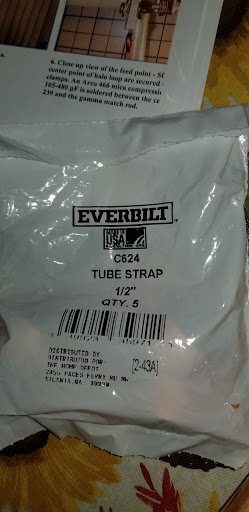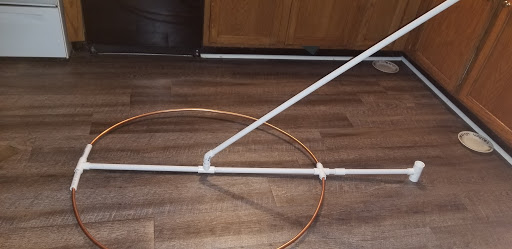How I built loops to get on the air for 6 meters.
When I went searching for information on 6-meter loops I found many many very well written construction articles but several of them had one thing in common: when it got to the antenna match they were often using old parts that were not weatherproof or not commonly available or the match would be built using something that the builder had in his junk box that wouldn't be duplicatable.
this was the basis for the loops I built, and provided the basic PVC support and loop dimensions.
I finally came across a design that used aluminum fuel hose and had a gamma match that was very duplicatable so I synthesized that into what I built for my six meter loops.
I built three loops so I could use two at the home qth and have one portable and I devised two different mounting methods where the antenna mounts to a mast that goes to the center of the loop or can be built for mounting on the side of a tower.
I jokingly call this antenna the 99 and 56/100 home Depot loop because I don't want to get a cease-and-desist order from a certain soap company and because the only pieces that you can't get at Home Depot are the UHF connector, the segment of rg213 that you'll need, and perhaps the heat shrink tubing that I used.
The copper pipe mounts into some PVC that forms the support for the antenna.
I used ⅜” ID for the main loop.
the gamma match is a segment of rg213 center conductor/insulation (braid and jacket removed) that slides into a smaller diameter (⅜” OD) copper tube.
a copper pipe bracket is flattened and soldered to the loop and gamma match tube. This, plus the feed connector, provided mechanical support for the match tube.

The UHF connector is bolted to wires soldered to the loop that emerge via slots cut in the pvc tee to support the antenna connector. I bent 1 wire to slide the wires into the PVC TEE, then bent it back.
once positioned, I cut the wires to length, and instaled a solder lug to bolt the UHF conenctor in place.
I used silicone RTV to seal and protect various pieces to keep moisture out and I also made a bit of a silicone plug for the end of each open tube such as the bottom of the mount or the end of the gamma match.
I also put silicone on the back of the antenna connector to protect the connection to the RG 213 center conductor.
the match is rather simple in that it is 14 inches of copper tube with a 14 inch piece of center conductor of rg213 with about 2 and 1/2 inches of the center conductor exposed.
using an antenna analyzer I tweaked the jumper from the gamma match tube to the main loop for best match and then soldered those in place with a plumbing torch. I used wooden clothes pins to hold the gamma tube in place during tuning as this allows the strap to be positioned for best match. Once the match location is found, mark the tubes and remove the pin on the main loop and slide the match wire out. Then using the torch, solder the strap in place. Once this is cool, replace the coax center conductor and secure to the main loop again. Solder the strap to the main loop.
this solder joint plus the stiffness of the wire to the UHF connector provide adequate support for the matching component.
I built two 3/4 wave Length of 75 ohm RG6 coax so that I could stack the antennas 5/8 wave apart on a mast
The loops are simply hose clamp connected to the mast that goes through the center of the loop.
one downside is that this means that the loop is not grounded to the mast so you may want to leave a couple of feet of mast tube of the loop for any kind of lightning protection.
I've added several photographs showing the PVC support and the loop construction and also illustrating the sidemount method of mounting the loop (note that this loop is laying upside down on the floor. I rotated the image to try to show the intent)

metal prices have risen so the antenna may not be as cheap as some of the other articles refer to.
I think I built these for maybe $100 total in materials.
The loops are currently on a mast I made with double wall construction consisting of 1-1/4 inch and 1-1/2 inch EMT metal tube.
I cut one piece of 1-1/4 inch EMT to five feet and put it inside so that the joints are offset 5ft within the mast. The mast is currently attached to the side of my house at about 14 ft and is 35 ft freestanding with loops mounted at 23 and 35 feet.
As always your mounting method is your choice and your mileage may vary
73 and gud luck!!
KI4US